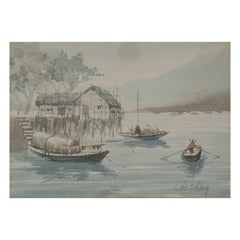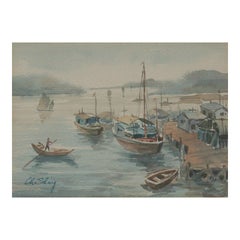Chi Shing
Mid-20th Century Chinese Chinoiserie Paintings and Screens
Metal
Mid-20th Century Chinese Chinoiserie Paintings and Screens
Metal
People Also Browsed
Early 2000s Italian Mid-Century Modern Chandeliers and Pendants
Brass
Antique Late 19th Century Korean Edo Paintings and Screens
Paper
Mid-20th Century Chinese Showa Prints
Bamboo
Antique 19th Century Japanese Japonisme Furniture
Wood
Antique 19th Century Japanese Meiji Commodes and Chests of Drawers
Iron
Antique Mid-19th Century Japanese Meiji Paintings and Screens
Silk
Antique Early 19th Century Chinese Qing Center Tables
Elm, Burl
Early 2000s Italian Mid-Century Modern Chandeliers and Pendants
Brass
Antique 1890s Japanese Meiji Paintings and Screens
Gold Leaf
Antique Mid-19th Century Chinese Bird Cages
Wire
Antique 1820s Japanese Edo Paintings and Screens
Paper
Vintage 1960s Japanese Chinoiserie Ceramics
Ceramic
Antique 1690s Vietnamese Qing Ceramics
Ceramic
Antique 19th Century English Early Victorian Sofas
Leather
Antique Late 19th Century Chinese Chinoiserie Ceramics
Porcelain
Antique 19th Century Chinese Qing Ceramics
Porcelain
A Close Look at Chinoiserie Furniture
Emerging in the 17th century, chinoiserie appropriated the aesthetics and imagery of popular East Asian design for European-made versions. Reflecting the exoticization of China, Japan and other countries in this era, the word directly translates from French to “Chinese-esque,” which reveals its shortcomings as a style of furniture and decor that often stereotypically and reductively mimics Asian culture rather than showcasing and paying tribute to its artistic traditions.
The enthusiastically decorative chinoiserie style was propelled by influential tastemakers including French King Louis XIV, whose Trianon de Porcelaine in 1670 was inspired by Chinese architecture. Expanded trade between the East and West led to a demand for porcelain, lacquer objects, silk and other goods, which further informed the fanciful furniture being crafted in Europe.
Artisans working in the chinoiserie style used materials and elements like pagoda shapes, bamboo, lacquer surfaces, bird and flower motifs and other interpretations of Asian design on pieces that were frequently set against vibrant wallcoverings. This whimsical approach yielded chinoiserie furniture that boasted dramatic flourishes drawing on the natural world and reflected the dominance of Rococo during the 18th century.
As chinoiserie was shaped by approximations of Asian design by European creators, it had regional variations, such as Chinese Chippendale in England where cabinets, chairs and tea tables had wooden fretwork designs and “japanned” surfaces intended to resemble lacquer work that was created in East Asia. In North America, furniture makers in Boston and New York integrated chinoiserie-painted scenes into Queen Anne furniture.
Antique chinoiserie furniture has continued to be fashionable, from its popularity with decorators of the Hollywood Regency era — James Mont, Tommi Parzinger, William Haines and Samuel Marx favored the style — to contemporary interior designers, although it brings with it a complex history.
Find a collection of chinoiserie bedroom furniture, cabinets, decorative objects and more on 1stDibs.
Finding the Right Paintings-screens for You
Traditional Asian paintings were often created on scrolls and folding screens. Artisans made screens that could be folded up or spread out by connecting several panels using hinges. Today, antique Asian folding screens and paintings are sophisticated decorative accents that can serve as makeshift partitions to ensure privacy.
The original folding screens were created by Chinese artists. The earliest record of screens comes from the 2nd century B.C., and surviving examples date back to the Ming dynasty. Chinese painting utilizes many of the same tools as calligraphy — these screens were crafted from wood with painted panels featuring striking art or calligraphy that told cultural stories or represented nature and life in the area.
The practice was introduced to Japan, where paintings for screens were made on paper and silk, in the 8th century. These paintings frequently feature subjects such as landscapes, animals, flowers and Buddhist religious themes. Along with screens for tea ceremonies and dance backgrounds, there were screens for use in Shinto and Buddhist temples.
In the 17th century, screens began to be imported to Europe where their popularity grew. Coco Chanel famously collected Coromandel folding screens.
Traditional Asian paintings can make a tasteful addition to any wall, and screens can be used as decoration or, in the case of larger iterations, as an aesthetic way to divide a large room. Browse the selection of antique Asian paintings and screens from a variety of styles and eras on 1stDibs.

